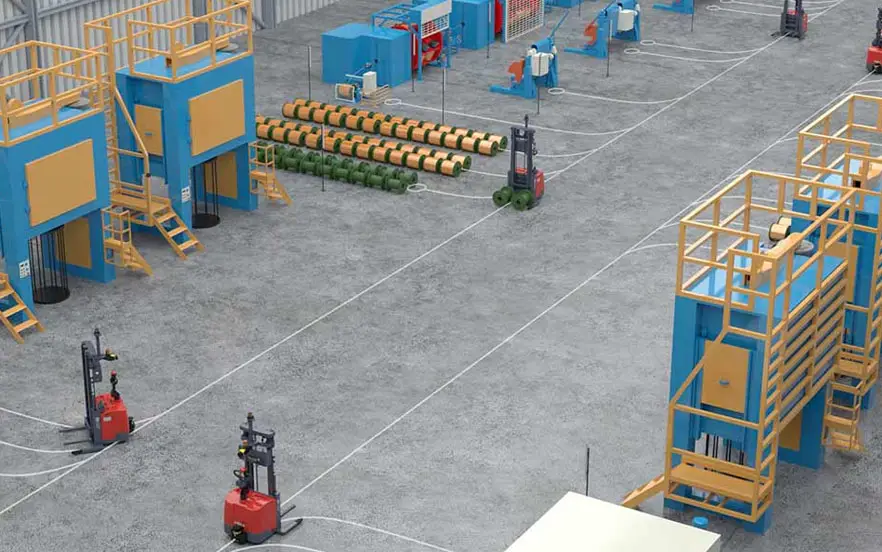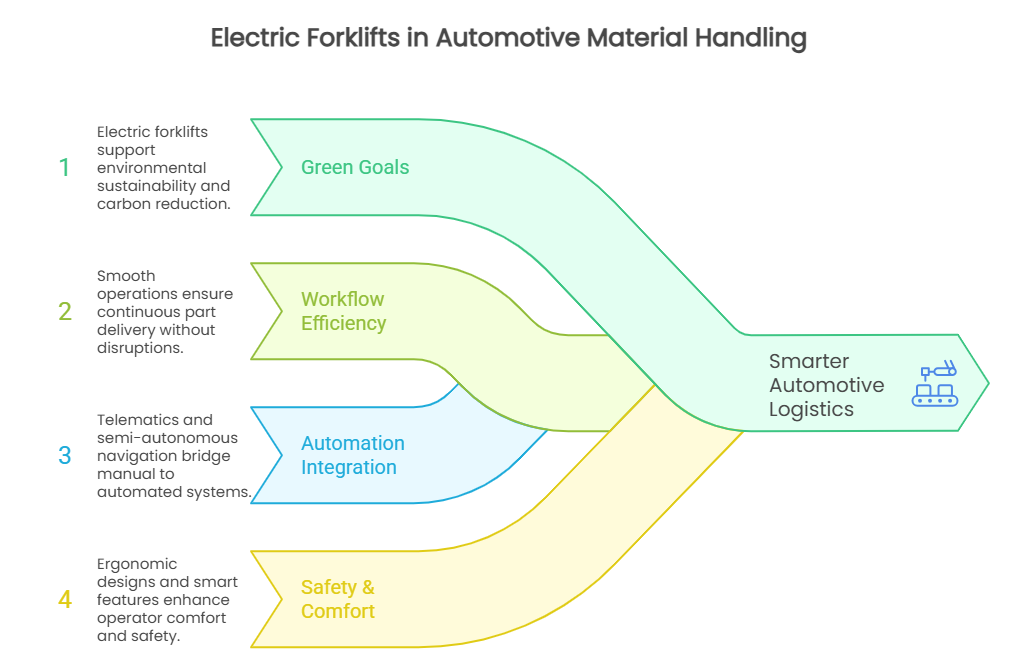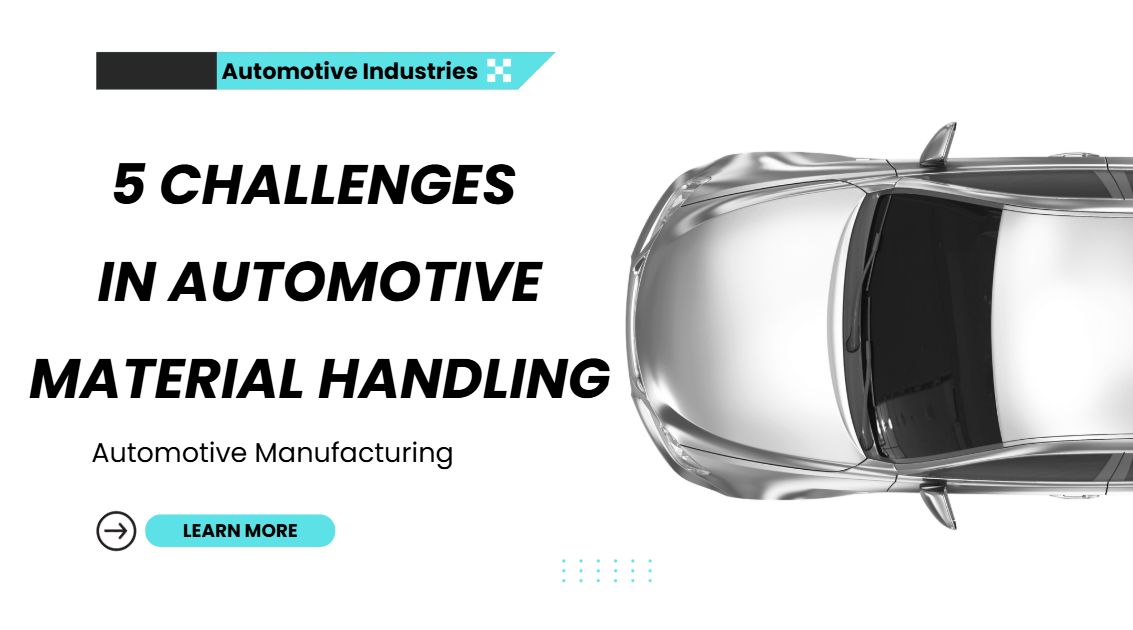5 Biggest Challenges in Automotive Material Handling
Inside a car plant, automotive material handling is the deliberate movement of parts, tools, and bodies from the dock to each work station. When that flow delivers items right on time, workers avoid waiting, and parts avoid damage. Those time savings shrink cycle time. The result is more cars out the door for less money.
Yet achieving this seamless flow is far from easy. This article will explore the top challenges in automotive material handling and offer practical insights for overcoming them.
Challenge 1: Manage Diverse and High-Volume Parts in Automotive Assembly
One car holds about 30,000 individual items, right down to each bolt. Model variants—gas, hybrid, and EV—stack extra part numbers onto that already huge list. Keeping those numbers straight burdens planners, pickers, and aging IT built for simpler times.
The wide mix tempts firms to overstock slow movers, yet they still suffer stock-outs. Parts must reach the line just-in-time and often in precise build order. That timing demands tight supplier coordination and real-time visibility across trucks, warehouses, and docks. When a tote is late, automotive material handling crews scramble while risking costly line stops.
Challenge 2: Ensure Safety in Fast-Paced Automotive Assembly Environments
What keeps production moving can also put workers at risk. From heavy loads to high-speed cycles, automotive material handling presents a unique set of safety challenges.
- Manual lifting of engines and transmissions strains the back and shoulders.
- Forklift or AGV collisions in tight aisles.
- Pinch and crush points when palletizing or positioning body panels.
- Slips or trips on oil, stray parts, or packaging debris.
- Falling objects from overhead cranes or hoists.
- Operator fatigue and errors under tight takt times.
- Repetitive twisting to reach racks causes musculoskeletal disorders.
- Heat stress while moving racks near weld cells and ovens.
- Blocked sightlines when towing tall tugger carts near pedestrians.
- High-voltage shock or thermal runaway when handling EV battery packs.
Additionally, keeping people safe on a hectic line means baking compliance into every move: follow OSHA’s powered-industrial-truck rules, design and operate forklifts to ANSI B56.1, apply the new ANSI/ASSP heat-stress guideline, and run an ISO 45001 safety-management system so automotive material handling and assembly stay on schedule without putting anyone at risk.
Challenge 3: Maintain Efficiency Amid Complex Assembly Processes
Multi-step car builds pass through welding, paint, trim, and final lines. Each handoff can stall if the next station waits. A single workstation with low capacity or downtime quickly piles up queues behind it. Parts shortages or external supply shocks freeze jobs between steps and idle crews.
Studies show seconds lost at conveyors compound into hours of daily lost output. Every stall triggers extra forklift runs to buffer areas, adding distance and slowing flow.
To meet takt, inbound logistics must deliver each kit to its station just in time. Digital twins now track trucks, tuggers, and AGVs in real time so planners catch slips early. Smarter routing and cross-docking cut travel minutes and free floor space, keeping the assembly heartbeat steady. When processes sync, automotive material handling crews spot shortages early and keep forklifts off critical paths. It allows plants to hit output targets without overtime or costly shutdowns.

Challenge 4: Reconcile Automation with Aging Infrastructure
Assembly line automation is widely adopted to accelerate production and meet tight deadlines. However, these fast-paced schedules leave little room for error or downtime.
Robots, AGVs, and smart conveyors cost a lot and collide with decades-old conveyors, PLCs, and IT. Installing them forces a delay while engineers redo floor paths and safety zones in narrow aisles. Those pauses and big bills breed caution, slowing adoption when gains look clear.
Workers must learn robot teaching, sensor checks, and automated guided vehicle traffic control, yet time and cash for classes remain tight. New control applications must link to old MES and ERP stacks, and mismatched data blocks real-time dashboards. Until those gaps close, automotive material handling crews juggle manual carts beside shiny robots every shift.
All these issues create significant barriers that slow down the seamless integration of automation in automotive material handling.
Challenge 5: Meet Sustainability Goals in Automotive Material Handling
Automotive manufacturers face increasing pressure from regulators, investors, and customers to reduce their environmental impact. Car makers face growing heat from regulators, investors, and buyers to clean up their operations. EU rules demand a 55% cut in CO₂ for new cars by 2030 and will phase out petrol and diesel sales from 2035[1]. The Science-Based Targets initiative adds that brands must trim total emissions by about 4.2% every year to stay on a 1.5°C path[2].
While broad policies set ambitious targets for vehicle emissions and energy use, material handling operations within manufacturing plants offer a significant yet often overlooked area to reduce environmental impact.
These operations contribute to a significant portion of a plant’s energy use and emissions due to the movement of parts, tooling, and assemblies across the factory floor and warehouses. Inefficient routing, reliance on fossil-fueled forklifts, and frequent equipment idling can contribute to unnecessary energy consumption and carbon emissions.
Therefore, to meet sustainability goals, manufacturers need to streamline material handling for lower emissions.
A Smarter Way to Move: Electric Forklifts for the Automotive Sector
The challenges in automotive material handling are real and growing—rising part complexity, intense safety demands, aging infrastructure, and mounting pressure to cut emissions. As manufacturers seek smarter, cleaner, and more flexible solutions, one technology is quietly transforming the factory floor: the electric forklift.
Far beyond being just a green alternative, electric forklifts now offer the precision, connectivity, and safety required to navigate today’s automotive assembly lines.
- Support Green Goals
Powered by electricity instead of fossil fuels, electric forklifts produce zero tailpipe emissions, helping manufacturers reduce their carbon footprint and meet sustainability targets.
- Maintain Workflow Efficiency
Smooth acceleration, low noise levels, and tight turning radii allow electric forklifts to support continuous, just-in-time part delivery without disrupting surrounding operations.
- Support Automation and Digital Integration
Many electric forklift models can be paired with telematics or fleet management software, or even semi-autonomous navigation, bridging the gap between manual operations and future-ready automation systems.
- Enhance Operator Comfort and Safety
Ergonomic designs paired with customizable features, such as air conditioning, heaters, fire extinguishers, and speed limit alarms, help reduce operator fatigue and ensure safe operation in demanding environments.

With over 65 years of industry experience, HELI stands as one of the most trusted names in material handling. As a pioneer in intelligent logistics, HELI offers a comprehensive lineup of electric forklifts designed to meet the unique demands of automotive manufacturing, from compact models for tight indoor spaces to high-capacity solutions for heavy-duty applications.
Ready to power your automotive assembly line with smarter, safer, and greener solutions? Explore HELI’s full range of forklift solutions and discover how we can support your next move in intelligent material handling.
References
- The state of emissions reduction in the automotive industry. Available at: https://www.rsm.global/insights/state-emissions-reduction-automotive-industry(Access on July 9, 2025)
- Green progress or green gap: How does the automotive sector align with the EU’s sustainability targets? Available at:https://www.deloitte.com/us/en/insights/topics/environmental-social-governance/automotive-industry-sustainability.html(Access on July 9, 2025)

